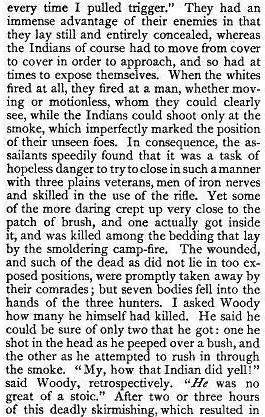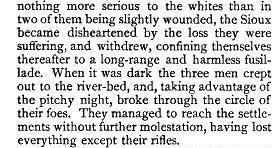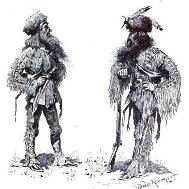
Frederic Remington - 1890
Tazewell Woody
Australian Gold Prospector in 1856 and Yellowstone River
Trapper in 1875
Tazewell (Taswell, Tazwell) Woody, one of the younger brothers of Sparrell, was born
in 1832. Somewhat amazingly, he is
one of the main characters mentioned in the recollections of Theodore Roosevelt entitled "In Cowboy-Land"
This article (image at the bottom of this page) was published May, 1893 in The Century, a popular magazine of the
period. Roosevelt recounts a story told to him
by his guide and "friend" Tazewell Woody. Tazewell's adventure took
place in the spring of 1875 when he and two friends were trapping on the
Yellowstone River. However, before Tazewell found his way to the Yellowstone
River, he was a prospector in the gold-fields of New South Wales where the
discovery of gold in 1851 ignited the first of many Australian gold rushes.
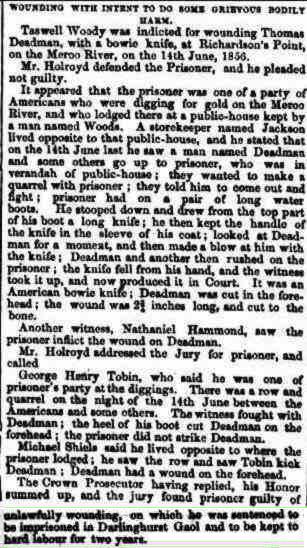 Here, on June 14, 1856, he was involved in a serious incident for which he was
sentenced to two years at hard labor in the Darlinghurst Gaol. We do not know if
Tazewell served his full sentence, but he was recorded in the 1860 Tulare
County, California census. On September 27, 1856, The Sydney Morning
Herald published the article on the right. The Meroo River is about 150 miles
northwest of Sydney, just west of the town of Mudgee. Our thanks go to Ray Debnam
of Australia, who brought this article to our attention. Ray's
great-great-grandfather was Thomas Deadman, the victim mentioned in the article.
Here, on June 14, 1856, he was involved in a serious incident for which he was
sentenced to two years at hard labor in the Darlinghurst Gaol. We do not know if
Tazewell served his full sentence, but he was recorded in the 1860 Tulare
County, California census. On September 27, 1856, The Sydney Morning
Herald published the article on the right. The Meroo River is about 150 miles
northwest of Sydney, just west of the town of Mudgee. Our thanks go to Ray Debnam
of Australia, who brought this article to our attention. Ray's
great-great-grandfather was Thomas Deadman, the victim mentioned in the article.
We will
probably never know exactly how Roosevelt and Tazewell Woody became friends, but it
is known that Roosevelt engaged hunting guides in Bozeman, Montana in 1886. It would seem that Tazewell became a mountain man, hunter, trapper, army scout, guide
and woodcutter after leaving
his brother Sparrell in California sometime after 1860. On his way to Montana
from California, Tazewell seems to have passed through Washington Territory. In
another of his many articles, Roosevelt retells a Tazewell Woody bear story that
occurred "at one of the Puget Sound ports". However, the first post-1860 primary
reference to Tazewell that we have found is in the 1870 Bozeman,
Montana census. Here he was enumerated
as a woodcutter living next to infamous Col. Eugene Baker and his troops at Fort Ellis.
Fort Ellis had been established in 1867 in response to almost continual strife
between aggressive settlers and Indians intent on protecting their homelands. Although the
abovementioned Roosevelt article does not give the names of Woody's
companions or the exact date and location of the Yellowstone River incident, other articles name
Harris/Lew Hubble and Charley Cocke as the trappers, June 24, 1875 as the date and
Beauvais Creek as the location. This creek is about fifteen miles west of the
site of the Battle of the Little Bighorn
where, on June 25/26 1876, General George Custer and his command were virtually annihilated by a
combined force of Sioux and Cheyenne. We do not think it is a coincidence that
Beauvais Creek is about four miles from Woody Creek, both being tributaries of
the Bighorn River. Near
the headwaters of Woody and Beauvais Creeks stands Woody Mountain. Beauvais
Creek, Woody Creek, Woody Mountain and the battle site are now on the Crow Indian Reservation.
We have not been able to locate
Tazewell in the 1880 census; however, Michael L. Collins, one of the many
biographers of Theodore Roosevelt, writes that "In September 1891, Roosevelt
returned to western Wyoming....in pursuit of the noble elk.... Roosevelt
hired as his guide a tall, quite mountaineer named Tazewell Woody". A former
California prospector and army scout, "old Woody" was likeable, witty,
according
to Roosevelt, representative of "a true type of fast-vanishing race of game
hunters and Indian fighters". A large area encompassing the
headwaters of the Yellowstone River was designated the world's first national
park in 1872. In 1897 and 1898, the Department of the
Interior, recorded an ageing Taswell Woody a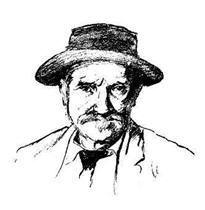 s a registered guide for Yellowstone National
Park. In the summer of 1897, the noted author and wildlife artist, Ernest Seton
Thompson, aka Ernest
Thompson Seton, visited Yellowstone to sketch wildlife, especially the large
grizzlies that frequented the garbage dump. Here he also sketched Tazewell Woody
(left)
and the other guides that stayed at the hotel and frequented the hotel bar of "Uncle" John Ya
s a registered guide for Yellowstone National
Park. In the summer of 1897, the noted author and wildlife artist, Ernest Seton
Thompson, aka Ernest
Thompson Seton, visited Yellowstone to sketch wildlife, especially the large
grizzlies that frequented the garbage dump. Here he also sketched Tazewell Woody
(left)
and the other guides that stayed at the hotel and frequented the hotel bar of "Uncle" John Ya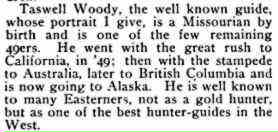 ncey at
Pleasant Valley. Seton described Woody as "a
forty-niner and a favorite scout in the Yellowstone region". (Click
here for a photo of Tazewell,
his sister Sarah & some of their family) The image on
the right is Seaton's description of Tazewell in another article published in
November, 1897. This is the only other mention of of Tazewell's Australian trip
that we have found. Tazewell returned to Missouri before the 1900
census and in the 1910 Morgan County, Missouri census, he was recorded as married for the
first time when he was about seventy-three. Tazewell Woody died in 1916 and is
buried with his wife Martha Clay Woody in a very small Morgan County cemetery overlooking the Lake of the
Ozarks.
ncey at
Pleasant Valley. Seton described Woody as "a
forty-niner and a favorite scout in the Yellowstone region". (Click
here for a photo of Tazewell,
his sister Sarah & some of their family) The image on
the right is Seaton's description of Tazewell in another article published in
November, 1897. This is the only other mention of of Tazewell's Australian trip
that we have found. Tazewell returned to Missouri before the 1900
census and in the 1910 Morgan County, Missouri census, he was recorded as married for the
first time when he was about seventy-three. Tazewell Woody died in 1916 and is
buried with his wife Martha Clay Woody in a very small Morgan County cemetery overlooking the Lake of the
Ozarks.
Theodore Roosevelt (1858-1919) was a man of many talents. On his way to becoming
the 29th President of the United States in 1901, he gained national
attention for his leadership of the Rough Riders in the 1898 Spanish American
War. He was born into a moderately wealthy New York family and graduated from
Harvard. He entered Columbia Law School in 1880, but his political ambitions led
to his election to the New York State Assembly at age 23. After the death of his
1st wife and mother on the same day, Roosevelt moved from New York to
the North Dakota Badlands in 1883. Although he lived in the Badlands for only
two years, he returned many times to hunt. In the west, he became a rancher and
an avid hunter. This experience probably led to his later leadership in the
conservation movement. His association with the people on the frontier seems to have profoundly altered his view of the factors that he used to
evaluate human worthiness. Historians have commented that Roosevelt learned to value character and accomplishments and
to place less emphasis on wealth, social standing and formal education.
Another of Roosevelt's interests was
historical writing. Although
his first book was The Naval War of 1812, published in 1882, much
of his literary work was based on his experiences in the Badlands and the
surrounding area. "I never would have been President if it had not been
for my experiences in North Dakota", said Roosevelt. After his
return to New York, Roosevelt wrote many articles and books about his experiences
in the west. He
seemed especially fond of recounting the stories that he was told by the cowboys,
guides and mountain men with whom he had worked and hunted.
He did not hesitate to repeat the same stories many times in his many
publications and stories about Tazewell Woody were among his favorites. His choice of subjects
was likely influenced by Easterner's never ending fascination with western culture and
characters. Whatever his motivation, his literature sold well and further enhanced his
reputation. The demand for first hand accounts of the wild west must have been
monumental, since other writers and editors often repeated Roosevelt's stories
in their own publications. Other big game hunters, turned authors, described
their hunts with Woody. In the
July-December, 1891 issue of Scribner's Magazine, Archibald Rogers, also a
friend of Roosevelt, recounts an
undated hunting trip in northwest Wyoming. "Here, to, I find my trusty friend
and companion of all my hunting trips, Tazwell Woody, a grizzled veteran of the
mountains, who once long ago claimed Missouri as his home". He also writes about
Woody's favorite horse "old Rock". Even Tazewell's horse made good copy.
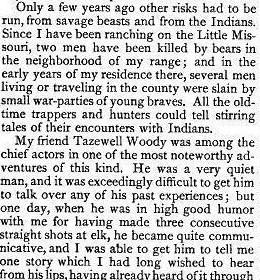
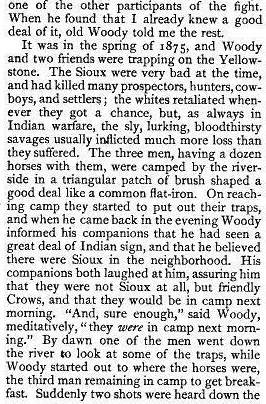
.jpg)
.jpg)
